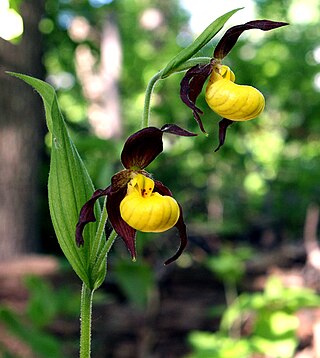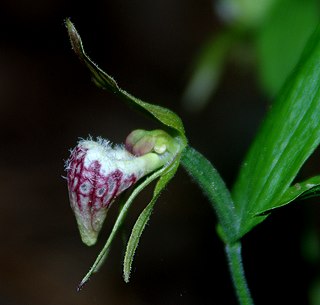
Cypripedioideae is a subfamily of orchids commonly known as lady's slipper orchids, lady slipper orchids or slipper orchids. Cypripedioideae includes the genera Cypripedium, Mexipedium, Paphiopedilum, Phragmipedium and Selenipedium. They are characterised by the slipper-shaped pouches of the flowers – the pouch traps insects so they are forced to climb up past the staminode, behind which they collect or deposit pollinia, thus fertilizing the flower. There are approximately 165 species in the subfamily.

Cypripedium is a genus of 58 species and nothospecies of hardy orchids; it is one of five genera that together compose the subfamily of lady's slipper orchids (Cypripedioideae). They are widespread across much of the Northern Hemisphere, including most of Europe and Africa (Algeria), Russia, China, Central Asia, Canada the United States, Mexico, and Central America. They are most commonly known as slipper orchids, lady's slipper orchids, or ladyslippers; other common names include moccasin flower, camel's foot, squirrel foot, steeple cap, Venus' shoes, and whippoorwill shoe. An abbreviation used in trade journals is "Cyp." The genus name is derived from Ancient Greek Κύπρις (Kúpris), an early reference in Greek myth to Aphrodite, and πέδιλον (pédilon), meaning "sandal".

Calypso is a genus of orchids containing one species, Calypso bulbosa, known as the calypso orchid, fairy slipper or Venus's slipper. It is a perennial member of the orchid family found in undisturbed northern and montane forests. It has a small pink, purple, pinkish-purple, or red flower accented with a white lip, darker purple spottings, and yellow beard. The genus Calypso takes its name from the Greek signifying concealment, as they tend to favor sheltered areas on conifer forest floors. The specific epithet, bulbosa, refers to the bulb-like corms.

Platanthera praeclara, known as the western prairie fringed orchid and the Great Plains white fringed orchid, is a rare and threatened species of orchid native to North America.

Cypripedium acaule is a species of flowering plant in the orchid family Orchidaceae native to eastern North America. It is currently the provincial flower of Prince Edward Island, Canada, and the state wildflower of New Hampshire, United States.

Cypripedium parviflorum, commonly known as yellow lady's slipper or moccasin flower, is a lady's slipper orchid native to North America. It is widespread, ranging from Alaska south to Arizona and Georgia. It grows in fens, wetlands, shorelines, and damp woodlands.

Cypripedium dickinsonianum is a species of orchid known as Dickinson's lady's slipper or Dickinson's cypripedium after American orchidist Stirling Dickinson.

Cypripedium guttatum, the spotted lady's slipper or Alaskan lady's slipper, is a species of orchid found on three continents. Each stem has about two clasping leaves that alternate. The plant has a height of 12 centimeters to 35 centimeters. The magenta and white colored labellum is pitcher shaped.

Cypripedium reginae, known as the showy lady's slipper, pink-and-white lady's-slipper, or the queen's lady's-slipper, is a rare lady's-slipper orchid native to northern North America. Although never common, this plant has vanished from much of its historical range due to habitat loss. It is the state flower of Minnesota.

The Manitoba Tall Grass Prairie Preserve is located in southeastern Manitoba near Gardenton and Vita, this is about 50 kilometres (31 mi) south of Steinbach, Manitoba. It is one of the last remaining stands of tallgrass prairie in Manitoba and is part of the Tallgrass Aspen Parkland conservation area in Manitoba and Minnesota. Several groups and organizations help in land preservation in the Manitoba Tall Grass Prairie such as the Nature Conservancy of Canada, Nature Manitoba, Environment Canada, Manitoba Conservation and the Manitoba Habitat Heritage Corporation.

Cypripedium calceolus is a lady's-slipper orchid, and the type species of the genus Cypripedium. It is native to Europe and Asia.

Grass Wood is an ancient woodland of 88 hectares in Wharfedale, North Yorkshire, England, that has an exceptional ground flora of woodland wildflowers.

Cypripedium arietinum, the ram's head lady's slipper, is a rare terrestrial orchid that grows in lightly to heavily shaded areas with calcareous soils. It is characteristic of the alvars around the Great Lakes in North America]. In Canada, it is found from Quebec to Saskatchewan, plus an isolated population in Nova Scotia, where it grows on gypsum based soils, 330 km away from the nearest population in Maine.

Galearis rotundifolia is a species of flowering plants in the orchid family, Orchidaceae. It is commonly called roundleaf orchis and small round-leaved orchid. It is a succulent perennial herb native to North America, where it occurs throughout Canada, part of the northern United States, and Greenland.

Cypripedium passerinum is a species of lady's slipper orchid known by the common names sparrow's-egg lady's-slipper, spotted lady's-slipper, and Franklin's lady's-slipper.

Spiranthes magnicamporum, commonly called the Great Plains lady's tresses, is a species of orchid that is native to North America. It is primarily native in the Great Plains, but there are outlying populations in the east in areas of former natural grassland, such as the Black Belt prairies of the Southeast. It is found in both fens and wet and dry prairies, often in calcareous soil.

Megachile melanophaea is a species of leaf-cutter bee in the family Megachilidae. It was first described by the British zoologist Frederick Smith in 1853. It is native to North America.




















